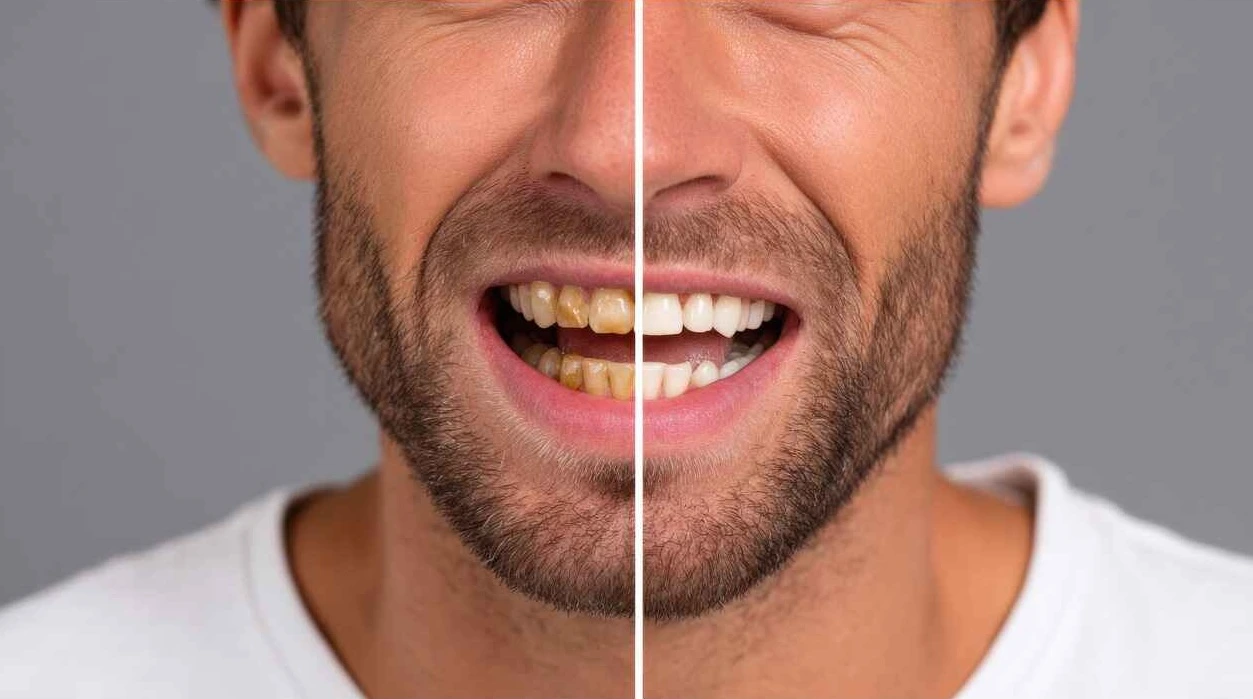


It’s a crisp October morning in Vista, and you’re holding your favorite pumpkin spice latte, ready to start the day. You take a sip and glance at the mirror—suddenly, those yellowish stains on your teeth catch your eye. Sound familiar? You’re not alone. Coffee lovers across the city notice the same thing, especially during fall when warm drinks are part of the daily routine. While coffee fuels our mornings and cozy afternoons, it can also leave a noticeable mark on our smiles.
At Main Street Dental in Vista, CA, we’ve seen firsthand how coffee and other dark beverages affect teeth. But don’t worry—stains don’t have to be permanent. With the right combination of professional care and smart at-home habits, you can maintain a bright, healthy smile even if coffee is your go-to drink.
Coffee stains happen because of tannins, naturally occurring compounds that give coffee its rich color and flavor. These tannins stick to enamel, the outer layer of your teeth, creating a yellow or brown tint over time. Dark-colored beverages like tea, red wine, and even some sodas can also contribute to discoloration.
The problem isn’t just the color—it’s how long the coffee sits on your teeth. Sipping slowly throughout the day keeps enamel in contact with staining compounds, making discoloration more likely. Enamel that’s already thin or worn is especially vulnerable, as stains penetrate more easily.
While anyone can develop coffee stains, certain factors increase the likelihood:
Recognizing these risk factors helps you take action early before stains become stubborn.
You don’t have to wait until your teeth look noticeably yellow to take action. Watch for:
Early intervention makes professional whitening and at-home strategies more effective.
.webp)
At Main Street Dental, our team uses a careful approach to evaluate tooth discoloration:
Professional evaluation ensures your teeth are healthy before applying whitening treatments.
Even before whitening, a professional cleaning removes surface stains, plaque, and tartar that brushing alone cannot eliminate. This gives teeth a cleaner, brighter appearance and improves the effectiveness of other treatments.
.webp)
For deeper stains, professional whitening is the most effective solution. Options include:
Whitening not only improves aesthetics but also boosts confidence and encourages better oral care habits.
For minor surface stains, dentists can use polishing techniques or microabrasion to remove discoloration without affecting enamel integrity.
Even with professional care, daily habits matter. Try these strategies:
Close-up of teeth with coffee stains, illustrating discoloration and need for whitening
.webp)
Myth 1: Brushing immediately after coffee prevents stains.
Fact: Wait 30 minutes after drinking coffee to brush. Immediate brushing can damage softened enamel.
Myth 2: Whitening damages teeth.
Fact: When done under dentist supervision, whitening is safe and preserves enamel integrity.
Myth 3: Only coffee stains teeth.
Fact: Tea, red wine, berries, and even dark sauces can contribute to discoloration.
Myth 4: Home remedies like lemon juice work.
Fact: Acidic solutions can erode enamel, causing more harm than good. Always consult your dentist first.
Q: How long does professional whitening last?
A: Results vary but typically last 6–12 months with good oral hygiene and stain management.
Q: Can coffee stains ruin enamel?
A: Stains alone don’t damage enamel, but acidic beverages or improper brushing can.
Q: Are at-home whitening kits effective?
A: They can help mild stains, but professional treatment is safer and more effective for deeper discoloration.
Q: Can children get coffee stains?
A: Rarely, but any dark beverage can stain developing enamel. Monitor intake carefully.
Q: How often should I get dental cleanings to prevent stains?
A: Every six months is ideal, though heavy coffee drinkers may benefit from more frequent cleanings.
Enjoy your favorite coffee this fall without worrying about stains! Schedule a professional cleaning or whitening consultation at Main Street Dental in Vista, CA. Our skilled team will assess your teeth, recommend the best treatments, and help you maintain a bright, healthy smile all season long.
Address: 1830 Hacienda Dr. Suite 1, Vista, CA 92081
Phone: 760-295-9870